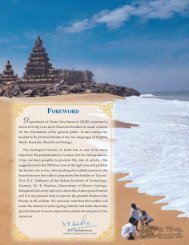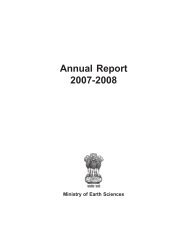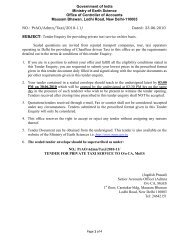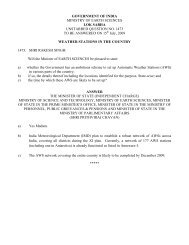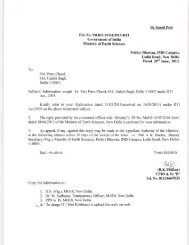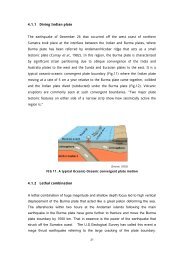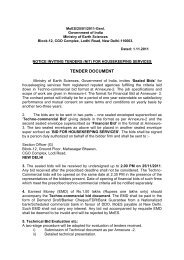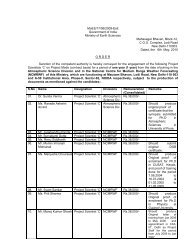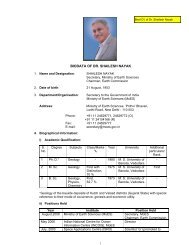1) Microzonation main Volume - Ministry Of Earth Sciences
1) Microzonation main Volume - Ministry Of Earth Sciences
1) Microzonation main Volume - Ministry Of Earth Sciences
- No tags were found...
Create successful ePaper yourself
Turn your PDF publications into a flip-book with our unique Google optimized e-Paper software.
Introduction and Background Information <strong>Microzonation</strong> mapping of seismic hazards can be expressed in relative or absolute terms, on an urbanblock-by-block scale, based on local conditions (such as soil types) that affect ground shaking levels orvulnerability to soil liquefaction. Intensity (I O ) is represented in the Modified Mercalli Intensity (MMI) scale which is commonly used inthe world by seismologists. Intensity ratings are expressed as Roman numerals between I at the low endand XII at the high end. Magnitude concept was introduced by Richter (1935) to provide an objective instrumental measure ofthe size of earthquakes. Magnitudes are evaluated from measured amplitude and period of seismicsignals recorded at a seismic station. For a given earthquake, the amplitude decreases with increasingdistance (due to attenuation of the signals) and a distance dependent correction is applied. Themagnitudes are classified based on different calculation procedures and the definition for differentmagnitudes scales followed in the report is given below and their relation with moment magnitude isalso given. Local magnitude (M L ) scale is referred as Richter magnitude scale. Charles Richter used Wood-Anderson Seismometer to define a magnitude scale for shallow and local (epicenteral distance less thanabout 600km) earthquakes in southern California (Richter 1935). This magnitude scale is the bestknown and most commonly used magnitude scale (Day, 2002). Surface wave magnitude (M S ) is calculated based on the amplitude of surface (Rayleigh) waves havinga period of about 20s (Gutenberg and Richter, 1956). The surface wave magnitude uses the maximumground displacement, which can be obtained from any type of seismograph. But in local magnitude themaximum trace amplitude of Wood-Anderson seismograph is used. This magnitude scale can be usedfor moderate to large earthquakes having a shallow focal depth but the seismograph should be 1000kmaway from the epicenter (Day, 2002). Body wave magnitude (m b ) is used to measure the deep-focus earthquakes, which is based onamplitude of the first few cycles of P-waves (Gutenberg, 1945). Intraplate earthquake can berepresented by Body wave magnitude (m bLg ), which is estimated from the amplitude of one-second –period, higher –mode of Rayleigh waves (Kramer, 1996). Coda magnitude (M C ) is obtained from characteristics of backscattered waves (Aki, 1969) that followpassage of primary (unreflected) body and surface waves. Moment magnitude (Mw) is world wide more commonly used scale to determine the magnitude oflarge earthquakes. It represents the entire size of the earthquake and is calculated from seismic moment(Kanamori, 1977) and is not based on ground shaking levels.1.4.1 Macrozonation and <strong>Microzonation</strong>Seismic zonation is usually carried out in two parts; one is macro level and another one micro level. For a largerarea like zonation of country or continent macro level is adopted. Macrozonation are carried out considering theseismicity, geology in lager scales without considering geotechnical aspects. But microzonation is carried out insmaller scale by considering regional seismicity, geology and local site conditions. This microzonation isleveled or graded based on scale of the study and details of geology and geotechnical inputs.3




